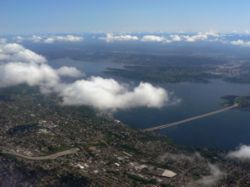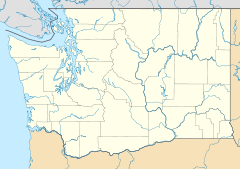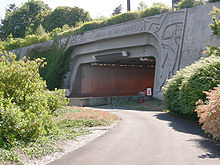- Mount Baker Tunnel
-
Mount Baker Ridge TunnelView of the Mount Baker Tunnel and the Lacey V. Murrow Memorial Bridge from the southwest
Location: E of WA 90, Seattle, Washington Coordinates: 47°35′25″N 122°17′55″W / 47.59028°N 122.29861°WCoordinates: 47°35′25″N 122°17′55″W / 47.59028°N 122.29861°W Built: 1940 Architect: Bates & Rogers Construction Corp. Architectural style: Art Deco Governing body: State MPS: Historic Bridges/Tunnels in Washington State TR NRHP Reference#: 82004243[1] Added to NRHP: July 16, 1982 The Mount Baker Tunnel or Mount Baker Ridge Tunnel carries Interstate 90 under the Mount Baker neighborhood of Seattle, Washington. It is actually a group of four tunnels that carry eight lanes of freeway traffic, plus a separate tunnel for bicycles and pedestrians. The two originals are twin tunnel bores completed in 1940 and rehabilitated in 1993. Two double-decked tunnels and the bicycle/pedestrian tunnel were built north of the original tunnels in 1991.
The entire tunnel is listed on the National Register of Historic Places (NRHP), ID #82004243.[2] The east portals of the tunnel, along with the Lacey V. Murrow Bridge, are an official City of Seattle landmark.[3]
The official length is 1,440 feet (440 m)[4], though the perceived length while driving is closer to a 1 kilometre (3,300 ft) because of a cut-and-cover "lid" between the western portal and the beginning of the actual tunnel under the Mount Baker ridge. The eastern end of the tunnel links to the I-90 floating bridge on Lake Washington.
At 63 feet (19 m) in diameter, it is the world's largest diameter soft earth tunnel, having been bored through clay.[4][5][6]
Contents
Configuration
Original
When completed in 1940, the twin tunnels connected the I-90 floating bridge on Lake Washington and Rainier Avenue South in Seattle. The bridge and tunnels were part of US Highway 10, which used surface streets between the tunnels and downtown Seattle. US 10 was a four-lane, undivided highway. Each tunnel held two traffic lanes. The north tunnel normally carried two westbound lanes. The south tunnel normally carried two eastbound lanes. In the 1960s, a lane-use signal system was added to improve peak commute traffic. During peak commute times, the signals were used to make the center two lanes reversible. In the mornings, three lanes flowed west and one lane flowed east. In the evenings, three lanes flowed east and one lane flowed west. During morning and evening commutes, one tunnel carried two lanes of traffic in the same direction while the other tunnel carried opposing traffic separated by only dashed yellow lines.
The highway would later become part of Interstate 90, be expanded, and upgraded to a controlled access freeway. The freeway expansion and upgrade was completed in 1993.
Current
Upon completion of the I-90 expansion, the freeway capacity increased to three general purpose lanes in each direction and two reversible HOV lanes. Eastbound traffic uses the original tunnels. Westbound traffic uses the upper deck of the northern new tunnel. A two-lane reversible roadway uses the lower deck. The reversible roadway serves as express lanes for transit buses and carpools (2+ people) during peak commute periods. The express lanes flow westbound on week day mornings and eastbound on week day afternoons and evenings. On weekends, the express lanes are open; traffic direction is variable depending on anticipated traffic volumes. When the express lanes are open to eastbound traffic, single occupant vehicles headed to Mercer Island are allowed to use the lanes.
Future use
The Washington State Department of Transportation is renovating I-90 between Interstate 5 and the East Channel Bridge to add one HOV lane in each direction. WSDOT is also modifying the Bellevue Way exit and entrance ramps. On Mercer Island, WSDOT and Sound Transit are building direct access ramps to allow buses and HOVs to exit and enter I-90 from the future HOV lanes. When the HOV lanes and direct access ramps are complete, the express lanes will be dedicated to Eastside Link light rail use.
Sound Transit will soon begin to build light rail rapid transit in the current I-90 Express Lanes for the East Link light rail line connecting Seattle with the Bellevue and Redmond suburbs. Voters in urban and suburban King, Pierce, and Snohomish counties rejected the measure on November 6, 2007, as part of an $18 billion "Roads and Transit" construction package, but approved the plan a year later as part of a transit-only initiative.
References
- ^ "National Register Information System". National Register of Historic Places. National Park Service. 2009-03-13. http://nrhp.focus.nps.gov/natreg/docs/All_Data.html.
- ^ King County listings at the National Register of Historic Places
- ^ Landmarks Alphabetical Listing for L, Individual Landmarks, Department of Neighborhoods, City of Seattle. Accessed 28 December 2007.
- ^ a b Preliminary List of Nationally and Exceptionally Significant Features of the Interstate Highway System (US DOT)
- ^ WSDOT historic bridges
- ^ Alaskan Way Viaduct and Seawall Replacement - Frequently Asked Questions (see What experience does WSDOT have with building tunnels?)
Bridges and tunnels in and around Seattle Road bridges: Alaskan Way Viaduct | Ballard Bridge | Cowen Park Bridge | East Channel Bridge | Evergreen Point Floating Bridge | First Avenue South Bridge | Fremont Bridge | George Washington Memorial Bridge (Aurora Bridge) | Homer M. Hadley Memorial Bridge (Third Lake Washington Floating Bridge) | Jose Rizal Bridge | Lacey V. Murrow Memorial Bridge (I-90 Floating Bridge) | Magnolia Bridge | Montlake Bridge | North Queen Anne Drive Bridge | Schmitz Park Bridge | Ship Canal Bridge | South Park Bridge | Spokane Street Bridge | 20th Avenue NE Bridge | University Bridge | West Seattle BridgeRail bridges/trestles: Tunnels: Battery Street Tunnel | Great Northern Tunnel | Mercer Island Lid | Downtown Seattle Transit Tunnel | Mount Baker Tunnel | Convention Center-Freeway Park Lid | Beacon Hill TunnelU.S. National Register of Historic Places Topics Lists by states Alabama • Alaska • Arizona • Arkansas • California • Colorado • Connecticut • Delaware • Florida • Georgia • Hawaii • Idaho • Illinois • Indiana • Iowa • Kansas • Kentucky • Louisiana • Maine • Maryland • Massachusetts • Michigan • Minnesota • Mississippi • Missouri • Montana • Nebraska • Nevada • New Hampshire • New Jersey • New Mexico • New York • North Carolina • North Dakota • Ohio • Oklahoma • Oregon • Pennsylvania • Rhode Island • South Carolina • South Dakota • Tennessee • Texas • Utah • Vermont • Virginia • Washington • West Virginia • Wisconsin • WyomingLists by territories Lists by associated states Other  Category:National Register of Historic Places •
Category:National Register of Historic Places •  Portal:National Register of Historic PlacesCategories:
Portal:National Register of Historic PlacesCategories:- Tunnels on the National Register of Historic Places
- National Register of Historic Places in Seattle, Washington
- Tunnels in Washington (state)
- Landmarks in Seattle, Washington
- Transportation in Seattle, Washington
- Buildings and structures in Seattle, Washington
- Buildings and structures on the National Register of Historic Places in Washington (state)
- Tunnels completed in 1940
Wikimedia Foundation. 2010.



